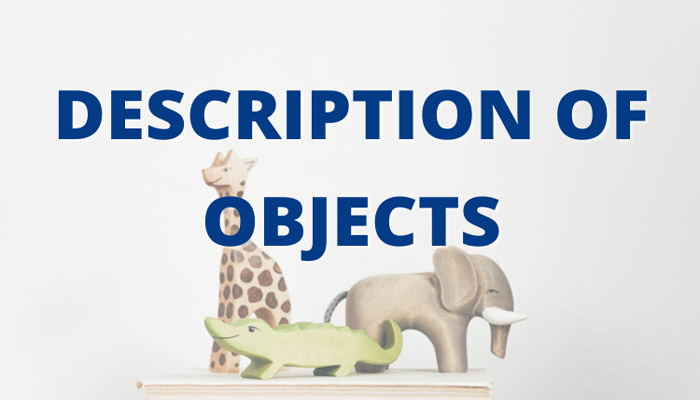Description of objects in Portuguese
Right after we talk about ourselves in Portuguese, we move on to describing what we have or what surrounds us. In addition to external characteristics, objects have a number and a position. Today we will learn how to ask, find out and give more details about objects.

Demonstrative pronoun
We already know that the pointing particles “isto, isso, aquilo” are chosen based on whether the object is near the speaker, near the speaker, or far from both. Demonstrative pronouns are chosen according to the same principle:
- este/esta (this, masculine/this, feminine) – next to the speaker;
- esse/essa (this, masculine/this, feminine) – next to the one they are talking to;
- aquele/aquela (those) – far from both.
Esta caneta é minha. Esse caderno é teu. (This pen is mine. This notebook is yours.)
Este supermercado é bom, mas aquele supermercado é popular. (This supermarket is good, but that supermarket is popular.)
Demonstrative pronouns are very similar in spelling and pronunciation, so it is important to remember their difference so as not to be confused. The main difference is that they answer completely different questions, but we will talk about this in more detail later.
Demonstrative adverb
The previous rule will greatly facilitate our task when studying demonstrative adverbs. They are divided according to the same principle:
- aqui (here) – when the object is near the speaker;
- aí (here) – when the object is near the person being spoken to;
- alí (there) – when the object is far from both interlocutors.
O supermercado é aqui e o hospital é ali. (The supermarket is here and the hospital is there.)
Estás aí? (Are you there?)
The last example is interesting. Usually they say this over the phone, but in relation to the speaker, his interlocutor is far away, somewhere there, and it would be more logical to use the word “alí”. But we are talking about the interlocutor, he is as close as possible to himself, so we use the adverb “aí“, wherever this person is.
Question words
The pointing particles “isto, isso, aquilo” answer the question “o que…?” (what…?). The demonstrative pronouns “este/a, esse/a, aquele/a” answer the question “qual/quais…” (which…?), and the demonstrative adverbs “aqui, aí, ali” answer the question “onde…?” (where?)
Onde estás? Estou aqui perto da tua casa. (Where are you? I’m here near your house.)
O que é isto? É a mochila dele, mas ele está ali, noutra sala. (What is it? It’s his backpack, but it’s there – in another class.)
Qual é o teu marido? Aquele, de altura média e com barba. (Which one is your husband? That one of medium height with a beard.)
Thus, we can clearly distinguish for ourselves three types of demonstrative parts of speech.
Adjectives
Adjectives are not an independent part of speech. They always refer to an object, which can be female or male, singular or plural. Adjectives also change their endings in the same way as the noun they refer to. Namely:
A casa bonita (beautiful house) – as casas bonitas (beautiful houses)
o número longo (long number) – os números longos (long numbers)
Similarly, the endings of the color of the object change, however, among the adjectives there are those that do not change depending on the gender, for example:
o prédio grande (big building) – a árvore grande (big tree)
o casaco verde (green jacket) – a folha verde (green leaf)
To make the plural form, we add the ending “-s“, but not for all adjectives. More precisely, there are exceptions, namely for adjectives that end in the letter “-l“. By birth, they also do not change, but the plural acquires the ending “-is“.
as linhas verticais (vertical lines) – os olhos azuis (blue eyes)
Ordinals
Ordinal numbers answering the same question “qual” (which one) follow the same rules as adjectives. However, the numeral itself and its ordinal form are most often not at all similar to each other, and they need to be learned:
- um (one) – primeiro/a/os/as (first)
- dois (two) – segundo/a/os/as (second)
- três (three) – terceiro/a/os/as (third)
- quatro (four) – quarto/a/os/as (fourth)
- cinco (five) – quinto/a/os/as (fifth)
In order not to list all ordinal numbers, in examples we will show how two-valued ones are formed:
Eu moro no décimo primeiro andar. (I live on the eleventh floor.)
Ele foi a Portugal pela vigésima e terceira vez. (He went to Portugal twenty-third time).
You may notice that in an ordinal number, both words that make up it change their form. But the rules are still the same – the endings change depending on the gender and number of the noun to which they refer.
Conclusion
When learning Portuguese grammar, it is not necessary to memorize the details. It is necessary to pay attention first of all to the general rules. That is, for example, based on the results of this article, we can conclude that any part of speech that refers to an object has the same gender and number.
This is enough to describe any situation and operate even with a small vocabulary in Portuguese. When the basics of the language are firmly fixed in your memory, then you can move on to the nuances, but not before. Otherwise, digging into the intricacies of the language, you can find it difficult and quickly lose motivation.
Leave a Reply